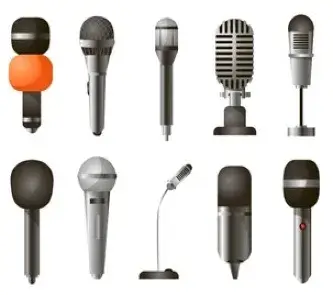10 Different Types of Microphones. There are various categories of microphones, each with its distinct way of capturing sounds that suit particular types of sound sources, such as instruments or vocal qualities. Some microphones may reject noise very well and have high directionality thus making them suitable for live performances while others are more effective at recording nuanced sound details which are ideal in a studio recording environment.
Microphones of various kinds exist, each with its use cases in audio recording and production. Below are the core categories:
What is Microphones
The electronic gizmo which transforms acoustic information into an electric signal is called a microphone. The microphone operates by picking up the sound waves (the air’s ripple pattern) and changing them into amperometric signals that could be amplified, recorded, or repaid because they are used variously such as in music recording or television production, and are often heard in telephones as a result of popularizing this communication medium.
How Microphones Function:
- The sound waves reach the diaphragm of the microphone (a delicate, malleable membrane).
- This causes it to vibrate in resonance with them.
- By the type of microphone used, these vibrations will then be transformed into an electric signal.
Types of Microphones
1. Dynamic microphones.
- Operating principle – It is characterized by a diaphragm attached to wire coils that move within magnetic field generating an electric signal.
- Live performances, and loud sound sources (e.g., drums and guitar amplifiers).
- Ideal for – live shows, sound recording of humans’ voice or musical instruments as well as broadcasting. Long-lasting, good at ignoring background noise, inexpensive.
- Examples: Shure SM58, Sennheiser MD421.
2. Condenser Microphones
- Operating principle -Thin diaphragm closely positioned to a backplate requiring phantom power.
- Ideal for – studio recordings, vocals and acoustic instruments.
- Examples Audio-Technica AT2020 and Neumann U87 are examples of these kinds of microphones.
3. Ribbon Microphones
- Operating principle – Use thin metallic ribbons suspended between magnets producing electrical signals.
- Advantages: Warm, natural sound; smooth and lifelike high-frequency response.
- Ideal for producing vintage sounds, recording vocals, and guitar amplifiers.
- Examples: Royer R-121, AEA R84
4. Lavalier Microphones
- Operating principle – Small clip-on devices using either dynamic or condenser technology.
- Ideal for carrying out interviews, television broadcasting, making presentations and theatrical performances.
- Small size; it doesn’t need hands hence makes it ideal for capturing speech.
- Examples would be Sennheiser ME 2 and Rode Lavalier.
5. Shotgun Microphones
- Operating principle – very directional mic having narrow pick-up pattern (cardioid or supercardioid).
- Ideal for Film production, TV programming, and field recording among others.
- Extremely focused on capturing external sound emanating from afar such as the voice of an actor in a movie.
- Some examples include Sennheiser MKH 416, Rode NTG4+.
6. USB Microphones
- How it Works: They are either condenser or dynamic microphones with built-in analog-to-digital converters that connect directly to computers via USB cables
- Best For: Podcasting, streaming, home recording.
- Some examples include Blue Yeti and Audio-Technica AT2020USB+
7. Boundary Microphones (PZM)
- How it Works: To obtain an even distribution of sound in a room, these microphones should be positioned close to reflective surfaces.
- Best For: Conference rooms, theater, ambient sound recording.
- Examples: Shure MX391, Crown PZM-30D.
8. Wireless Microphones
- How it Works: It consists of a dynamic or condenser microphone connected with the transmitter which sends audio wirelessly to receiver.
- Best For: Live events, presentations, and performances where mobility is required.
- Examples: Shure BLX288, Sennheiser EW 100 G4
9. Contact Microphones
- How it Works: Picks up vibrations directly from solid surfaces rather than through the air.
- Best For: Acoustic instruments like violins, guitars, or percussive instruments.
- Examples: K&K Sound Pure Mini, Schertler Basik.
10. Parabolic Microphones
- How it Works: Uses a parabolic reflector to collect and focus sound on microphone.
- Best For: Sports broadcasting, nature recording and long distance sound pickup.
- Examples: Telinga PRO-X, Klover Mik 26.
Each microphone type is tailored for its own purpose and has distinct features, whether they are live performances, studio recordings, film production or dedicated instrument. So the “best” microphone is determined by the specific application.
Frequently Ask Questations
Microphones differentiate in terms of type: Dynamic, Condenser, Ribbon, Lavalier and Shotgun. Every type serves a unique demand either for recording or performing live on stage.
What is the purpose of Dynamic Microphone?
Dynamic microphones have been tested against live show performances as well as with high intensity sounds such as from guitar amplifiers or drums where they have emerged tops owing to their strong nature that can take in any amount without breaking down
What is the comparison between condenser and dynamic microphones?
Condenser microphones tend to be more sensitive thereby providing better sound quality which makes them ideal for studio recording purposes. On the other hand, dynamic models destroy all background noise leaving clear vocals making it appropriate for use during stage performances.
Which type of microphone is appropriate in video production?
Amongst others shotgun microphones dominate this area due to their capability of shooting straight ahead only picking sound from one direction ignoring everything else around them.
